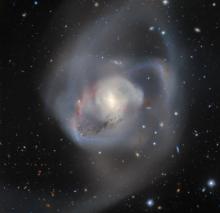Listen to today's episode of StarDate on the web the same day it airs in high-quality streaming audio without any extra ads or announcements. Choose a $8 one-month pass, or listen every day for a year for just $30.
You are here
Hidden Galaxy
The subtle glow of the disk of our home galaxy arcs across the sky on summer nights. It’s anchored in the south by the constellation Sagittarius, which forms the outline of a teapot.
The Milky Way’s glowing band hides many other astronomical wonders from view. That includes one of our closest companion galaxies. It’s a puffball compared to the Milky Way. And it’s being pulled apart by the Milky Way’s gravity. Still, it’s held on to enough of its material that it still looks like a galaxy.
The Sagittarius Dwarf Galaxy is only about 70,000 light-years away. By galactic standards, that’s just down the block.
The galaxy is located a bit to the upper right of Sagittarius’s teapot. But it’s behind some bright star clouds and dark dust clouds in the Milky Way. Combined with the fact that the dwarf galaxy is quite faint, that kept anyone from seeing it until just 25 years ago.
The Sagittarius dwarf is orbiting the center of the Milky Way. It periodically passes through the Milky Way’s disk, stirring up the stars around it. In fact, there’s evidence that a few hundred million years ago, it started a “wave” in the stars near the Milky Way’s heart that’s still rippling.
At the same time, the Milky Way is pulling some stars away from the dwarf galaxy. Some of them form a long streamer behind the galaxy. Others have been absorbed into the Milky Way’s disk. So the Sagittarius dwarf is slowly being consumed by the bigger galaxy: the Milky Way.






